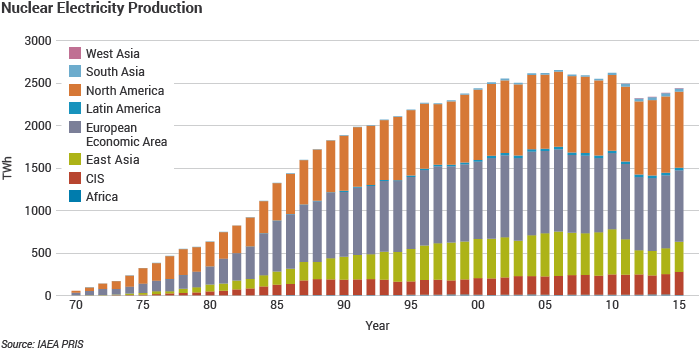The nuclear power industry has been in a state of flux since the 2011 Fukushima disaster, following which, Japan closed all of its nuclear power plants. Those closures were followed by declarations from several countries that they would also phase out or limit nuclear power generation. Germany has since closed 8 of its 17 reactors and plans to close the others by 2022. France, the world’s second largest nuclear producer after the US, has said as recently as 2015 that it intends to reduce its reliance on nuclear power by a third over the next 10 years (here).
Enjoy The Sounding Line? Click here to subscribe for free.
The bad news hasn’t stopped there. France’s nuclear giant EDF has been attempting to build several next generation ‘EPR’ nuclear reactors in Finland, China, France and the UK but the projects have been famously over budget and behind schedule. Finland’s Olkliuoto Nuclear Power Plant was supposed to be completed in 2009 for 3 billion euro. It’s still not finished and will cost more than 8.5 billion euro (here) whenever it’s finished. Similar debacles have done great damage to the idea that new technologies can propel the nuclear power industry back into a growth mode.
While uranium prices have fallen dramatically since 2011 it hasn’t been all bad news for the industry. A recent announcement from Kazakhstan that it intends to cut uranium production by 10% in 2017 sent prices rocketing earlier this week. More importantly, the US brought online its first new reactor since 1996 in 2016 and many developing nations like India, China, and Pakistan are actively building new reactors. In total 60 are under construction around the world with firm plans for 160 new reactors. That all leads to projections of a 30% increase in nuclear power generation in by 2030 (here).
The chart below from the World Nuclear Association shows nuclear power production by global region. Some recovery has taken place since 2011 but much greater growth will be needed to convince skeptics that nuclear power is a growth industry.

One thing will remain true, nuclear fuel has an energy density well over a million times higher than diesel/gas by weight. That meaning millions of times less fuel by weight is required to produce the same amount of energy. That simplifies supply chains and enables the storage of years worth of fuel, a huge geopolitical advantage. For that reason alone, nuclear power likely isn’t going anywhere.
P.S. If you would like to be updated via email when we post a new article, please click here. It’s free and we won’t send any promotional materials.
Would you like to be notified when we publish a new article on The Sounding Line? Click here to subscribe for free.

